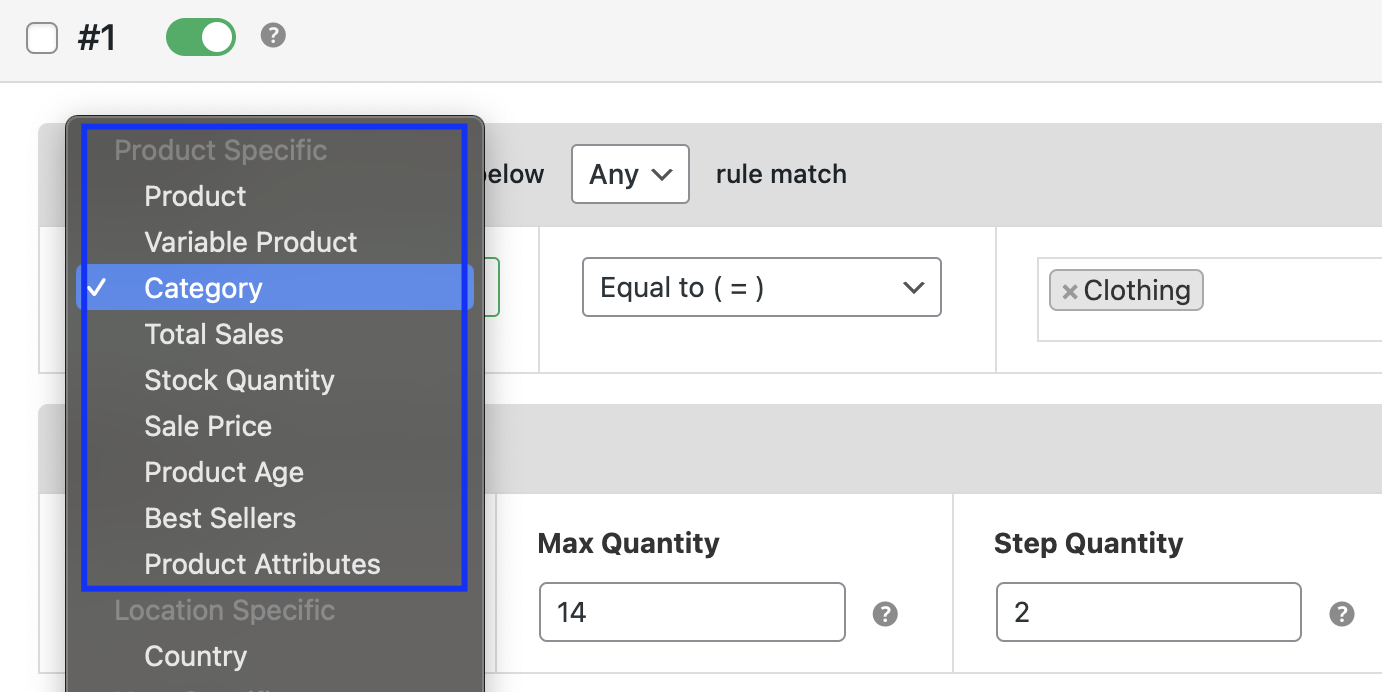How to create a product-specific quantity rule
The Minimum and Maximum Quantity for WooCommerce plugin allows you to apply quantity limits for specific products using various conditions. You can define rules that apply to individual products, product categories, or product attributes, helping you manage inventory more efficiently and enforce purchasing restrictions tailored to specific product needs.
Here are the different product-specific conditions you can set:
- Simple Product: Select individual simple products for which you want to enforce minimum or maximum quantity limits.
- Variable Product: Set specific min/max quantity rules for any variations within a variable product (e.g., size or color variations).
- Category: Apply quantity rules to all products within a specific category, ensuring consistent limits across an entire product range (e.g., electronics, apparel).
- Best-Selling Products: Restrict or control stock for top-selling products in your store by setting purchase limits to avoid stockouts.
- Product Attributes: Apply rules based on specific product attributes such as color, size, or material (e.g., limiting purchases of a particular size of clothing).
- Total Sales: Set minimum and maximum quantity limits based on the total number of units sold for a specific product, allowing you to control sales after reaching a certain threshold. Click here to learn more about this feature.
- Stock Quantity: Apply quantity restrictions based on available stock levels, ensuring that customers can only purchase within the set limits when the stock reaches a specific amount. Click here to learn more about this feature.
- Sale Price: Configure min/max quantity limits based on a product's sale or discounted price, letting you enforce restrictions on products with special pricing offers. Click here to learn more about this feature.
- Regular Price: Configure min/max quantity limits based on a product's regular price, letting you enforce restrictions on products with special pricing offers. Click here to learn more about this feature.
- Product Age: Set quantity limits based on the age of a product (days since launch), helping manage sales strategies for newly launched or older products. Click here to learn more about this feature.

Steps to Create Product-Specific Rules:
Go to the "Manage Rules" page in the plugin settings and click the "Add New" button to start creating a new rule.

Admin: Add new Min/Max quantity rule In the "Configuration" section, set the rule status (Active/Inactive) and assign a descriptive name to the rule, such as "Product Based Rule," to help you easily identify it later.

Admin: Rule status and name configuration In the "Advanced Rules > Conditions" section, select the specific products, categories, or attributes you want to target. You can configure different conditions based on product type (simple, variable), categories, attributes (e.g., size, color), and more.

Admin: Category based quantity rule In the "Advanced Rules > Action" section, define the minimum and maximum quantity limits for the selected products. You can also configure the default input value, step quantity, and input selector (e.g., dropdown, radio button) to control how customers interact with the quantity field.

Admin: Set min/max quantity and other action Save your changes to apply the product-specific rule.

Front: Product with defined min/max quantity, step quantity and quantity selector
Example Use Cases:
- Limited Edition Products: For limited edition products, you may want to set a maximum quantity rule to prevent bulk purchasing. For instance, you can limit each customer to purchasing only 2 units of a rare product.
- Bulk Purchasing Encouragement: If you sell products in bulk (e.g., office supplies), you can set a minimum quantity rule to encourage customers to buy in larger quantities (e.g., requiring a minimum of 10 pens to be purchased in one order).
- Restricting Best Sellers: For best-selling items that tend to sell out quickly, you can set a maximum quantity per customer to ensure fair distribution and prevent stock hoarding.
Note: You can combine product-specific rules with other conditions like user-specific rules to create a comprehensive checkout experience based on your business needs.




